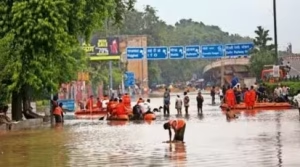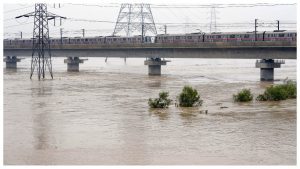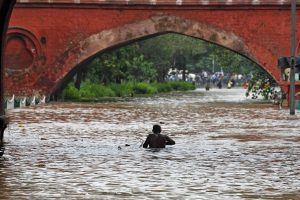New Delhi – Delhi’s transportation infrastructure faced significant challenges on Thursday as Waterlogging at Yamuna Bank Station and Kashmere Gate Inter-State Bus Terminal created access difficulties for thousands of commuters. Despite the flooding impact, both critical transport hubs maintained operational status while implementing emergency measures to serve passengers.
The Waterlogging at Yamuna Bank particularly highlighted the vulnerability of Delhi’s transport infrastructure to seasonal flooding, with the Yamuna River continuing to flow above danger levels throughout the week.
Kashmere Gate ISBT Battles Floodwater Intrusion

The Maharana Pratap ISBT at Kashmere Gate found itself surrounded by floodwaters, though officials confirmed that bus services continued operating despite the challenging conditions. This terminal serves as one of north India’s busiest transport hubs, handling passengers traveling to Haryana, Punjab, Himachal Pradesh, Jammu and Kashmir, and Uttarakhand.
While the Waterlogging at Yamuna Bank affected nearby areas, Kashmere Gate ISBT implemented protective measures to maintain functionality. Officials reported that water entered the terminal late Wednesday night but was successfully pumped out using emergency equipment installed after the 2023 flood experience.
Reduced Operations but Continued Service
Bus operations at Kashmere Gate ISBT experienced significant reduction due to the flooding conditions. A Delhi Transport Infrastructure Development Corporation Limited official revealed that daily operations dropped from the regular 1,800-2,000 buses to approximately 1,200 buses during Thursday’s waterlogging crisis.
Services to states including Himachal Pradesh, Jammu, and Punjab faced particular reductions due to weather conditions in upper regions, though the Waterlogging at Yamuna Bank area also contributed to operational challenges affecting passenger movement and bus scheduling.
Emergency Preparedness Measures Activated
Learning from the devastating 2023 flood experience, Kashmere Gate ISBT had implemented comprehensive flood protection measures including pumps and sandbags to block water inflow. These preparations proved crucial in maintaining operations despite the Waterlogging at Yamuna Bank affecting surrounding areas.
The proactive approach enabled terminal staff to quickly address water intrusion issues, pumping out accumulated water and maintaining essential passenger services including ticketing counters and waiting areas throughout the crisis period.
Metro Station Access Severely Compromised


The Waterlogging at Yamuna Bank Metro Station created more severe access problems, with the approach road becoming completely inaccessible due to rising water levels. The Delhi Metro Rail Corporation issued an advisory at 10:34 AM warning passengers about the access difficulties.
Despite road access problems, the Waterlogging at Yamuna Bank did not completely shut down metro operations. The station remained operational for train services and passenger interchanges, allowing commuters who arrived via metro to continue their journeys normally.
DMRC Maintains Limited Operations
The Delhi Metro Rail Corporation confirmed that trains continued halting at the affected station, with interchange services between the Blue Line’s Noida and Vaishali branches remaining unaffected. However, vehicular access remained completely blocked due to the Waterlogging at Yamuna Bank area.
DMRC officials emphasized that while the Waterlogging at Yamuna Bank prevented road access, passengers could still utilize the station for train connections as long as they arrived via metro rather than attempting road-based access to the facility.
Passenger Experience and Adaptations


Passengers visiting Kashmere Gate ISBT reported some delays in locating buses due to the flooding conditions, though the terminal remained functional with accessible ticketing and waiting facilities. The Waterlogging at Yamuna Bank area created additional navigation challenges for travelers unfamiliar with alternative routes.
Despite operational challenges, both transport hubs demonstrated resilience in maintaining essential services while managing the impact of the Waterlogging at Yamuna Bank and surrounding flood-affected areas through coordinated emergency response efforts.
River Level Monitoring and Traffic Advisories

The Yamuna River has maintained levels above the danger mark since earlier in the week, creating persistent waterlogging along the floodplain and adjoining roads. This sustained high water level contributed to the ongoing Waterlogging at Yamuna Bank and surrounding low-lying areas.
Traffic police issued comprehensive advisories recommending commuters avoid affected stretches, particularly near riverfront settlements and low-lying areas where vehicular movement remained restricted due to safety concerns and infrastructure limitations.
Infrastructure Vulnerability and Lessons Learned
The Waterlogging at Yamuna Bank incident demonstrates the ongoing vulnerability of Delhi’s critical transport infrastructure to seasonal flooding. Both affected facilities showed improved preparedness compared to previous flood events, though challenges remain in completely mitigating flood impact.
The experience highlights the importance of comprehensive flood management strategies for transport hubs located in flood-prone areas, with both Kashmere Gate ISBT and Yamuna Bank Metro Station serving as crucial case studies for future infrastructure planning.
Continued Monitoring and Service Updates
Officials continue monitoring water levels and infrastructure conditions to determine when normal operations can resume at both affected locations. The Waterlogging at Yamuna Bank situation requires ongoing assessment to ensure passenger safety while maintaining essential transport connectivity for Delhi’s millions of daily commuters.
Recovery efforts focus on restoring full access while preventing future disruptions through enhanced flood protection measures and improved emergency response protocols designed to minimize impact on Delhi’s critical transportation network.

